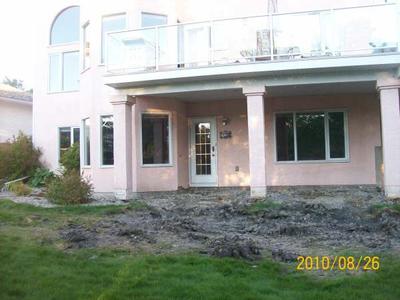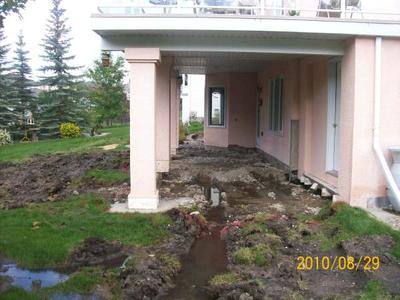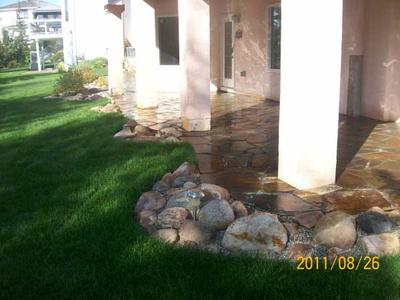Sodding Tips – Filling in Sod Seams
by Kevin
(Calgary)

Before picture of a sodding job.

After ripping out a concrete patio, we replaced it with stone, raised the height and resodded while blending to the existing lawn.

The gaps were filled in, and the following season you would never know it was done.
With the economic downturns in the global economy we can all stand to save a few bucks. With the internet being as helpful as it is, many people opt for do-it-yourself landscaping.
So with the spring season upon us, we thought it would be a great time to cover a few sodding tips.
For anyone interested in learning how to sod a yard, you can visit “Sodding a Lawn” in our how-to section. We have all the information you need in this comprehensive module to complete your lawn from start to finish.
Of all the great tips out there for sodding a lawn, I figured we would start with my favorite one.
Getting rid of the seams (gaps) between the sod pieces.
This is easiest and best way to have an awesome looking lawn in a matter of weeks. It looks like it was never sodded when done properly, and only requires one extra simple step. Filling in the seams with loam may take a few hours for a medium sized lawn, but is well worth the time and effort as it completes the work.
If you were installing your own drywall, would you leave out the taping and mudding step? Your room would look absolutely horrible if you left all those seams between the drywall pieces. So why do people not fill in the seams?
Landscapers have known about this technique for years, but very few of them actually do it. The sodding business is highly competitive with small profit margins, so labor costs usually prohibit this service from being offered.
In order for this to be an effective technique, you will also have to water properly. A newly laid lawn will require some extra care for the first 4 to 6 weeks until it is established. This means a thorough initial soaking, and regular watering after that.
If you don't give your lawn an initial soaking and moderate to heavier watering for at least the first week, you will find the pieces of sod will dry up and shrink from the moisture loss. This will actually increase the size of the gaps between the sod.
I am pretty sure all of you have seen the results of a lawn that was not watered properly in the first few weeks? I have seen yards 1 to 2 years later where you could still see the seems between the sod.
So how is it done?
Pretty simple really. All you have to do is to make sure you have some extra loam left over after the grading is done. If you haven't done this you may have to purchase an extra yard or two, depending on the size of your yard.
I like to do this step as I progress with the sodding itself. This saves from having to track over the newly laid sod. Just take your shovel full of dirt and shake it off along the crack where the pieces join.
Press the soil into the crack with your hand, foot, or other tool of your choice. The grass and roots will migrate into this soil rather quickly making the seams disappear.
Some people prefer to do this after all the sod has been laid down. You can also go back and do it after the first initial soaking has mostly dried up, but you should do it sometime in the first few days.
Just remember to stay off the lawn after watering. You may end up tracking the loam around the lawn, or make a muddy little mess stepping on the seams.
So that's my trick of the trade and I hope it helps you with your home project.
Blending a lawn is easy too. If you are looking to renovate, repair, replace, or rebuild a lawn, go to our section on lawn repair. We have 14 different sections to cover many different scenarios.
Thanks,
Kevin












